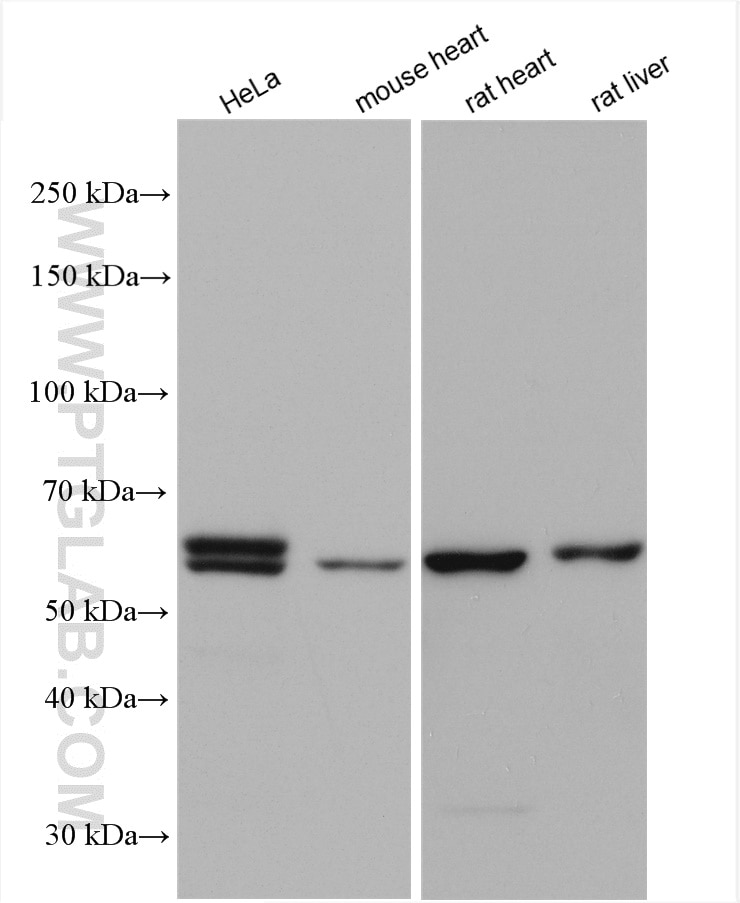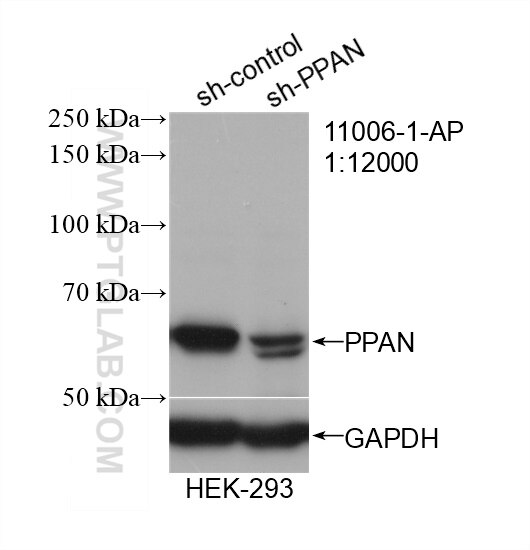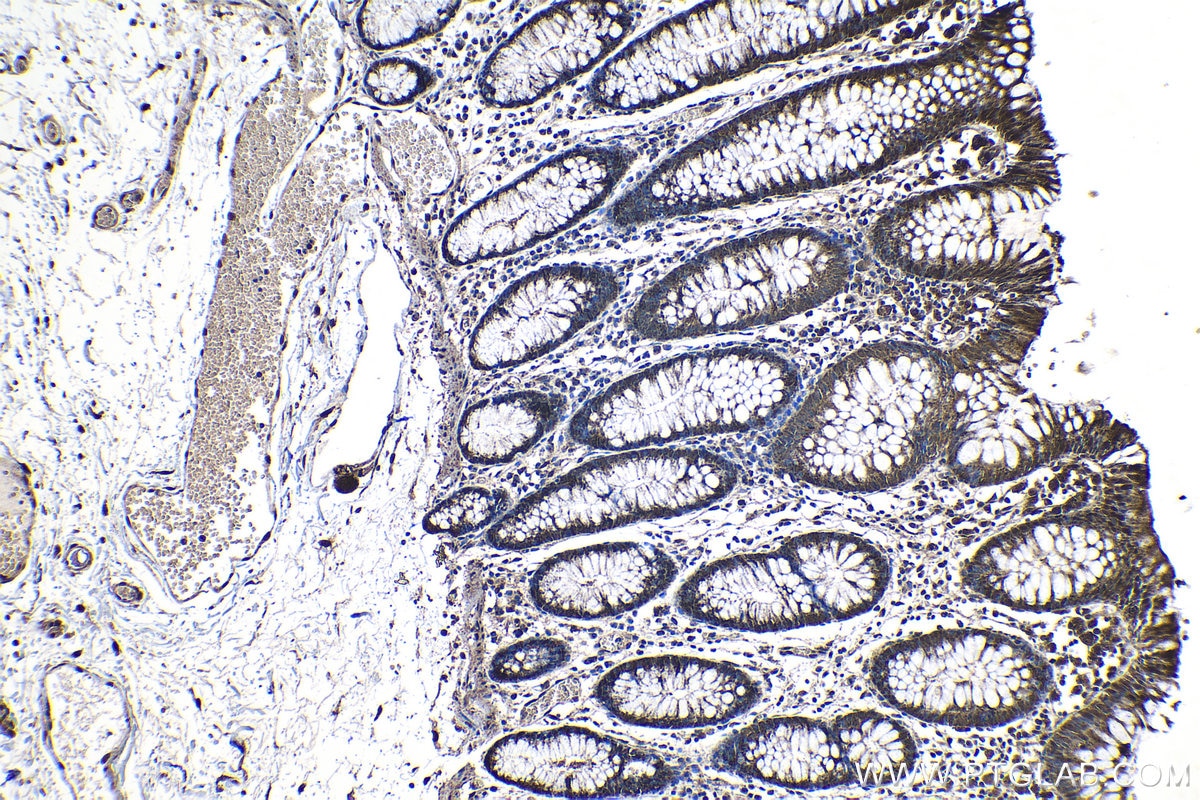- Featured Product
- KD/KO Validated
PPAN Polyklonaler Antikörper
PPAN Polyklonal Antikörper für WB, IHC, ELISA
Wirt / Isotyp
Kaninchen / IgG
Getestete Reaktivität
human, Maus, Ratte und mehr (1)
Anwendung
WB, IP, IF, IHC, ELISA
Konjugation
Unkonjugiert
Kat-Nr. : 11006-1-AP
Synonyme
Galerie der Validierungsdaten
Geprüfte Anwendungen
| Erfolgreiche Detektion in WB | HeLa-Zellen, Mausherzgewebe, Rattenherzgewebe, Rattenlebergewebe |
| Erfolgreiche Detektion in IHC | humanes Kolongewebe Hinweis: Antigendemaskierung mit TE-Puffer pH 9,0 empfohlen. (*) Wahlweise kann die Antigendemaskierung auch mit Citratpuffer pH 6,0 erfolgen. |
Empfohlene Verdünnung
| Anwendung | Verdünnung |
|---|---|
| Western Blot (WB) | WB : 1:1000-1:4000 |
| Immunhistochemie (IHC) | IHC : 1:500-1:2000 |
| It is recommended that this reagent should be titrated in each testing system to obtain optimal results. | |
| Sample-dependent, check data in validation data gallery | |
Veröffentlichte Anwendungen
| KD/KO | See 4 publications below |
| WB | See 6 publications below |
| IHC | See 1 publications below |
| IF | See 2 publications below |
| IP | See 2 publications below |
Produktinformation
11006-1-AP bindet in WB, IP, IF, IHC, ELISA PPAN und zeigt Reaktivität mit human, Maus, Ratten
| Getestete Reaktivität | human, Maus, Ratte |
| In Publikationen genannte Reaktivität | human, Maus, Krallenfrosch (Xenopus) |
| Wirt / Isotyp | Kaninchen / IgG |
| Klonalität | Polyklonal |
| Typ | Antikörper |
| Immunogen | PPAN fusion protein Ag1419 |
| Vollständiger Name | peter pan homolog (Drosophila) |
| Berechnetes Molekulargewicht | 53 kDa |
| Beobachtetes Molekulargewicht | 55-58 kDa |
| GenBank-Zugangsnummer | BC009833 |
| Gene symbol | PPAN |
| Gene ID (NCBI) | 56342 |
| Konjugation | Unkonjugiert |
| Form | Liquid |
| Reinigungsmethode | Antigen-Affinitätsreinigung |
| Lagerungspuffer | PBS mit 0.02% Natriumazid und 50% Glycerin pH 7.3. |
| Lagerungsbedingungen | Bei -20°C lagern. Nach dem Versand ein Jahr lang stabil Aliquotieren ist bei -20oC Lagerung nicht notwendig. 20ul Größen enthalten 0,1% BSA. |
Hintergrundinformationen
PPAN (or SSF, SSF1 or SSF2) gene is widely expressed, and encodes peter pan homolog protein which may be localized in nucleus. Two isoforms are produced through alternative splicing. So far the characterization of this protein is largely unknown, multiple phosphorylation sites has been revealed based on high-throughput phosphorylation analysis. This antibody is raised against the C-terminal of huaman PPAN and recognize bands around 55 kDa.
Protokolle
| Produktspezifische Protokolle | |
|---|---|
| WB protocol for PPAN antibody 11006-1-AP | Protokoll herunterladen |
| IHC protocol for PPAN antibody 11006-1-AP | Protokoll herunterladen |
| Standard-Protokolle | |
|---|---|
| Klicken Sie hier, um unsere Standardprotokolle anzuzeigen |
Publikationen
| Species | Application | Title |
|---|---|---|
EMBO J The long non-coding RNA Paupar promotes KAP1-dependent chromatin changes and regulates olfactory bulb neurogenesis. | ||
Development Peter Pan functions independently of its role in ribosome biogenesis during early eye and craniofacial cartilage development in Xenopus laevis. | ||
Cancers (Basel) Nucleolar Stress Functions Upstream to Stimulate Expression of Autophagy Regulators.
| ||
J Biol Chem The Wnt target Peter Pan defines a novel p53-independent nucleolar stress response pathway.
| ||
Biol Cell Pescadillo homologue 1 and Peter Pan function during Xenopus laevis pronephros development. | ||
Cells Loss of Peter Pan (PPAN) Affects Mitochondrial Homeostasis and Autophagic Flux.
|




